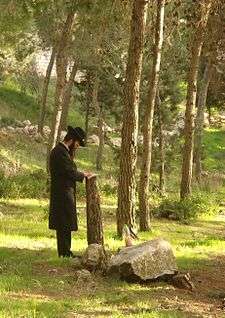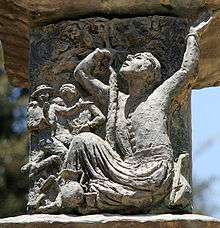Kavanah
Kavanah, kavvanah or kavana (also pronounced /kaˈvonə/ by some Ashkenazi Jews) (כַּוָּנָה; in Biblical Hebrew kawwānā), plural kavanot or kavanos (Ashkenazim), literally means "intention" or "sincere feeling, direction of the heart".[1][2] It is the mindset often described as necessary for Jewish rituals (mitzvot) and prayers.[3][4] Kavanah is a theological concept in Judaism about a worshiper's state of mind and heart, his or her sincerity, devotion and emotional absorption during prayers.[1][5]
| Part of a series on |
| Judaism |
|---|
   |
|
|
|
|
|
Other religions |
|
Related topics |
|
In Hasidic Judaism, a Jewish tradition that emphasizes piety, Kavvanah is the emotional devotion, self-effaced absorption during prayers rather than a liturgical recitation driven religiosity.[6][7] In esoteric Jewish mysticism (Kabbalah), Kavvanah refers to the practice where the devotee concentrates on the secret meanings of prayer letters and words,[6] sometimes referring to the permutations of the divine name.[8] Some kavanot are particular to the tradition of Kabbalah during meditation.[9]
Kavanah has been much debated subject among Judaism scholars, with traditional sources accepting that Jewish rituals without at least minimal kavanah is insufficient.[6][10] Different Jewish authorities see various levels of kavanah required for various rituals, and especially for prayer. Some prayerbooks (siddurim) list kavanot for particular prayers. Some particular kavanot are associated with particular holidays, for example Sukkot, Pesach, Shavuot,[11] and others.
Discussion


Kavvanah comes from an ancient verbal root also found where the object or subject is the "heart". It connotes "to direct, to prepare, to establish", an orientation of mind, heart, intention.[12] According to Moshe Halbertal, it implies concentration and sincerity, it is not rote recitation but the very essence of a prayer where the devotee expresses a plea and supplication to God, while really believing, feeling, meaning the prayer.[3] Kavvanah is both emotional and intellectual devotion, states Herman Cohen.[13] According to the rabbinic tradition, both action and proper intention is important during a prayer, and kavvanah refers to the latter. A related term in Judaism is kavvanot, states Pinchas Giller, which refers to "ideas, texts and formulae" to be contemplated during praying.[14]
Kavanah in prayer requires devotional belief and not merely reciting the words of a prayer.[7] According to Sutnick, this implies that the worshiper understand the words of the prayer and mean it, but this can be difficult for many Jews today when they pray using liturgical Hebrew, which many Jews outside of Israel do not understand.[15]
In Hasidism, it is one of four themes of religious worship and spiritual striving. The true faithful constantly contemplates the presence of the divine (hitbonenut), constantly cleaves and communes with the divine (devequt), intensely ecstatically feels the divine (hitlahavut), and is intently devoted to this divine (kavvanah).[16]
God was pleased with the heartfelt prayers and simple faith of ordinary Jews[17]
The Kavanah is therefore the strength that the devotee uses in the intention towards God: in other words, it is a sort of concentration followed by the truthful perception of a response to faith, that is, when one is certain that God listens, precisely during the ecstatic action of the bond with God, in this realization. According to the Hasidic tales but not only, children also know how to reach a good level of kavanah and it isn't absolutely useless to teach them Shema, even before Bar mitzvah
In Chovot HaLevavot
Chovot HaLevavot (Duties of the Heart) by Rabbi Bachya ben Joseph ibn Paquda (section 8, chapter 3), gives 3 general categories for kavanah under the rubric "the different ways of serving God":
- duties of the heart alone ( which is the subject of his book) To be humble and reverence respect to God and to Love God with all your heart, all your soul and all your strength (To love God with sincere and honesty) and keep your heart, your mind your thought to regard humility, reverence respect, to have good wills, loving kindness, morality & virtues towards God and towards another:
- duties of the body and heart together, such as prayer, Torah study, praising and glorifying God, teaching wisdom, enjoining right conduct, warning against evil, and the like;
- duties of the limbs alone, in which the heart has no part except for initially directing the act to God, for example sukkah, lulav, tzitzis, mezuzah, observing Shabbos and the festivals, giving charity, and similar duties in which distraction by other thoughts does not harm the one who performs them.
Kabbalah
In Kabbalah, Kavanah often refers to the permutations of the divine name that aim at overcoming the separation of the forces in the Upper World.[8]
See also
- Jewish meditation
- Unifications - Yichudim
- Deveikut
- Shaar HaKavanot
External links
References
- Pinchas Giller (2008). Shalom Shar'abi and the Kabbalists of Beit El. Oxford University Press. pp. 20–21. ISBN 978-0-19-971645-6.
- Babli, Berakhot 31a (Gemara) in Norman Solomon, ed. (2009). "First Tractate Berakhot (Blessings)". The Talmud: A Selection. Penguin. p. 23. ISBN 978-0-14-144178-8.
- Moshe Halbertal (2013). Maimonides: Life and Thought. Princeton University Press. pp. 266–267. ISBN 978-1-4008-4847-8.
- Eisenberg, Joice; Ellen Scolnic; Jewish Publication Society (2001). The JPS dictionary of Jewish words. Jewish Publication Society. p. 79. ISBN 0-8276-0723-7.
- Jack Cohen (2000). Major Philosophers of Jewish Prayer in the Twentieth Century. Fordham University Press. pp. 83–84, 3. ISBN 978-0-8232-1957-5.
- Kavvanah, Judaism, Encyclopædia Britannica
- Jack Cohen (2000). Major Philosophers of Jewish Prayer in the Twentieth Century. Fordham University Press. pp. 3–6, 15–16. ISBN 978-0-8232-1957-5.
- Buber, Martin (1974). Tales of the Hasidim - The Later Masters (7th ed.). New York: Shocken Books. p. 332. ISBN 0-8052-0002-9.
- Kaplan, Aryeh (1985). "3. Kavanot". Meditation and Kabbalah. Red Wheel. p. 214. ISBN 0-87728-616-7. Retrieved 2009-08-17.
- Shulchan Aruch 60:6 and 589:8
- Barenblat, Rachel (2005-07-13). "Kavanot for Shavuot". Ritualwell.org. Archived from the original on 2008-07-20. Retrieved 2009-08-17.
- John D. Rayner (1998). Jewish Religious Law: A Progressive Perspective. Berghahn. pp. 73–74. ISBN 978-1-57181-975-8.
- Herman Cohen (2000). Jack Cohen (ed.). Major Philosophers of Jewish Prayer in the Twentieth Century. Fordham Univ Press. pp. 14–15. ISBN 978-0-8232-1957-5.
- Pinchas Giller (2008). Shalom Shar'abi and the Kabbalists of Beit El. Oxford University Press. pp. 19–38. ISBN 978-0-19-971645-6.
- Sutnick, Barbara and Reuven (1999). "THE PRAYER BOOK: A WINDOW ON JEWISH THEOLOGY". Jewish University in Cyberspace (J.U.I.C.E.). Retrieved 2009-08-17.
- Adele Berlin (2011). The Oxford Dictionary of the Jewish Religion. Oxford University Press. p. 307. ISBN 978-0-19-973004-9.
- Cohn, Tzvi Meir. Baal Shem Tov Deuteronomy (p.35). BST Publishing